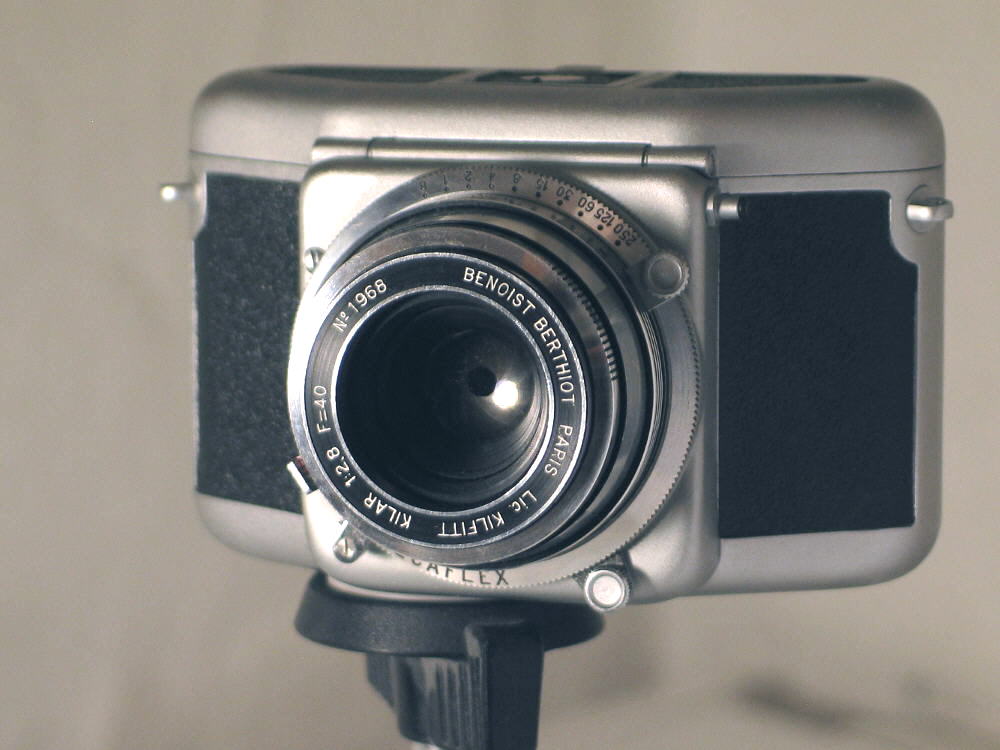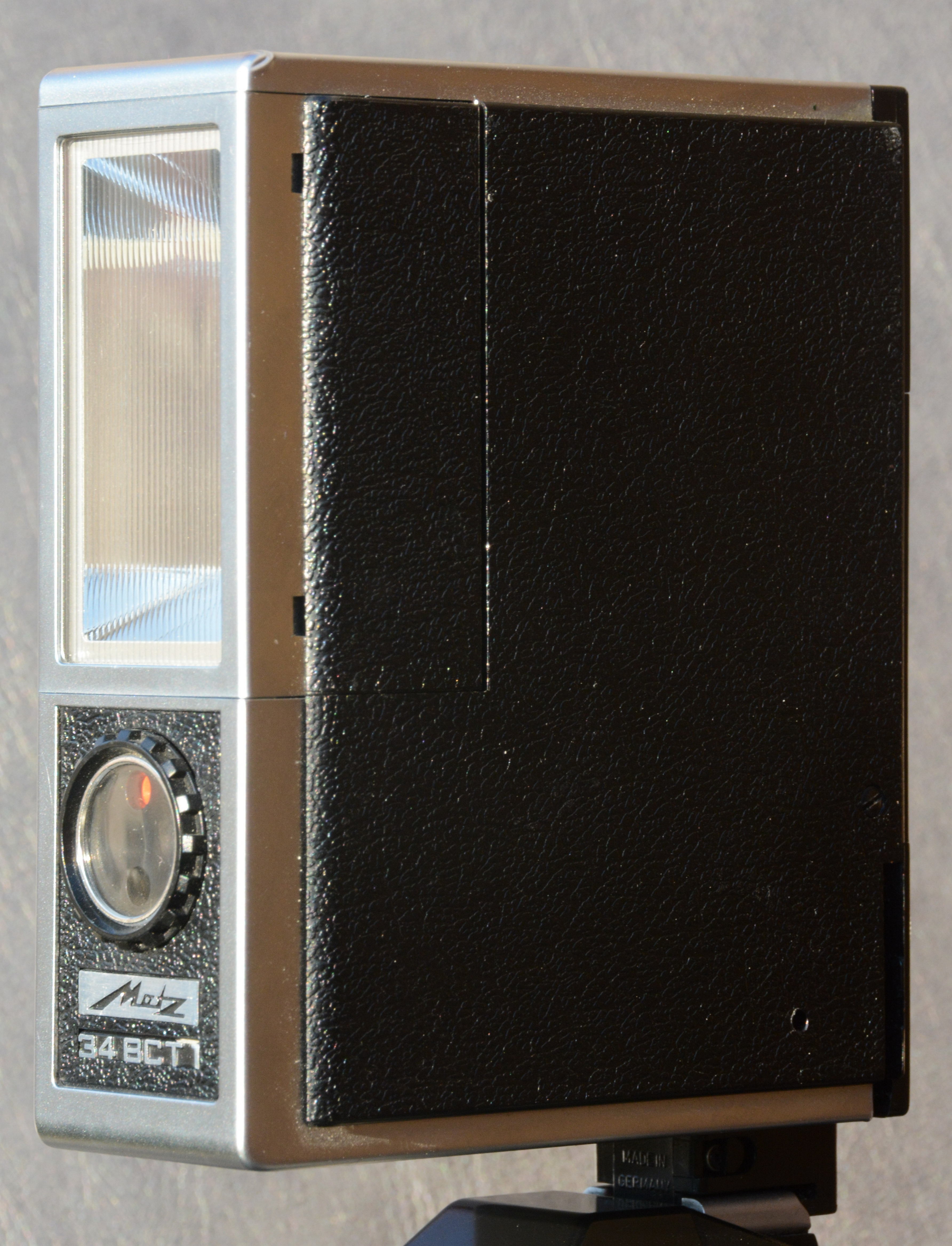|
Mecaflex Seroa
The Mecaflex is a 35mm SLR camera for 50 exposures of 24 × 24 mm. It was presented at the photokina in Cologne in 1951, and launched commercially about two years later. The design is by Heinz Kilfitt, who is also known for designing the original ''Robot camera'' and the ''Kowa Six''. The camera is equipped with the newly developed ''Prontor-Compur'' (PC) reflex shutter, which would pave the way for reputable camera designs such as the 1953 ''Contaflex'', the 1956 ''Retina Reflex'', the 1957 '' Hasselblad 500'', and the 1959 ''Voigtländer Bessamatic''. However, it does not have the built-in eye-level pentaprism finder, which was first seen on 35mm SLR cameras in 1949. Instead, it has a waist-level finder with a central split-image rangefinder complemented by large full frame magnifier incorporating a central loupe that covers the rangefinder central area. Description The complete camera top, hinged at the front, is a flush cover with no protruding controls. When flipped open ... [...More Info...] [...Related Items...] OR: [Wikipedia] [Google] [Baidu] |
Loupe
A loupe ( ) is a simple, small magnification device used to see small details more closely. They generally have higher magnification than a magnifying glass, and are designed to be held or worn close to the eye. A loupe does not have an attached handle, and its focusing lens(es) are contained in an opaque cylinder or cone. On some loupes this cylinder folds into an enclosing housing that protects the lenses when not in use. Optics Three basic types of loupes exist: * Simple lenses, generally used for low-magnification designs because of high optical aberration. * Compound lenses, generally used for higher magnifications to control optical aberration. * Prismatic, multiple lenses with prisms. Uses Loupes are used in many professions where magnification enables precision work to be done with greater efficiency and ease. Examples include surgery, dentistry, ophthalmology, the jewelry trade, gemology, and watchmaking. Loupes are also sometimes used in photography and printing. ... [...More Info...] [...Related Items...] OR: [Wikipedia] [Google] [Baidu] |
135 Film Cameras
135 may refer to: * 135 (number) * AD 135 * 135 BC *135 film 135 film, more popularly referred to as 35 mm film or 35 mm, is a format of photographic film used for still photography. It is a film with a film gauge of loaded into a standardized type of magazine – also referred to as a casse ..., better known as 35 mm film, is a format of photographic film used for still photography * 135 (New Jersey bus) {{numberdis ... [...More Info...] [...Related Items...] OR: [Wikipedia] [Google] [Baidu] |
Mecaflex Seroa
The Mecaflex is a 35mm SLR camera for 50 exposures of 24 × 24 mm. It was presented at the photokina in Cologne in 1951, and launched commercially about two years later. The design is by Heinz Kilfitt, who is also known for designing the original ''Robot camera'' and the ''Kowa Six''. The camera is equipped with the newly developed ''Prontor-Compur'' (PC) reflex shutter, which would pave the way for reputable camera designs such as the 1953 ''Contaflex'', the 1956 ''Retina Reflex'', the 1957 '' Hasselblad 500'', and the 1959 ''Voigtländer Bessamatic''. However, it does not have the built-in eye-level pentaprism finder, which was first seen on 35mm SLR cameras in 1949. Instead, it has a waist-level finder with a central split-image rangefinder complemented by large full frame magnifier incorporating a central loupe that covers the rangefinder central area. Description The complete camera top, hinged at the front, is a flush cover with no protruding controls. When flipped open ... [...More Info...] [...Related Items...] OR: [Wikipedia] [Google] [Baidu] |
Voigtländer
Voigtländer () was a significant long-established company within the optics and photographic industry, headquartered in Braunschweig, Germany, and today continues as a trademark for a range of photographic products. History Voigtländer was founded in Vienna, Archduchy of Austria, in 1756, by . Voigtländer produced mathematical instruments, precision mechanical products, optical instruments, including optical measuring instruments and opera glasses, and is the oldest name in cameras. Early beginnings Johann Christoph Voigtländer (November 19, 1732 in Leipzig – June 27, 1797 in Vienna), the son of a carpenter, came to Prague in 1755, and to Vienna in the same year, and worked from 1757 to 1762 in the workshop of Meinicke, who produced mathematical instruments. Through Johann Voigtländer's skilful achievements, the Minister of State of the Habsburg monarchy— Prince Wenzel von Kaunitz, drew attention to Voigtländer and Empress Maria Theresa of Austria granted Voigtlän ... [...More Info...] [...Related Items...] OR: [Wikipedia] [Google] [Baidu] |
Metz Apparatefabrik
Metz-Werke GmbH & Co. KG was a German consumer electronic manufacturer, Besides Loewe and TechniSat, Metz was the only remaining TV manufacturer which developed and produced their devices in Germany. Its head office is in Zirndorf, Bavaria. The company filed for insolvency in 2014 and backed up by new investors now reformed as two independent companies Metz Consumer Electronics GmbH and Metz mecatech GmbH since 2015. History * 28. November 1938: Paul Metz founds the company. * 1939: Manufacture of electronic devices for Carl Zeiss. Development of the product range through the manufacture of products with high-frequency technology. * until 1945: Production of radio technology for short-wave transmitters and receivers. * 1947: Consumer electronics division established with the manufacture of the first Metz radios. * 1950: Complete range of radio devices from the smallest Super radio to the radio gramophone. In keeping with the motto, "Metz - always 1st class", everything wa ... [...More Info...] [...Related Items...] OR: [Wikipedia] [Google] [Baidu] |
X Flash Synchronization
In photography, flash synchronization or flash sync is the synchronizing the firing of a photographic flash with the opening of the shutter admitting light to photographic film or electronic image sensor. In cameras with mechanical (clockwork) shutters synchronization is supported by an electrical contact within the shutter mechanism, which closes the circuit at the appropriate moment in the shutter opening process. In electronic digital cameras, the mechanism is usually a programmable electronic timing circuit, which may, in some cameras, take input from a mechanical shutter contact. The flash is connected electrically to the camera either by a cable with a standardised coaxial PC (for Prontor/Compur) 3.5 mm (1/8") connector (as defined in ISO 519), or via contacts in an ''accessory mount'' (hot shoe) bracket. Faster shutter speeds are often better when there is significant ambient illumination, and flash is used to flash fill subjects that are backlit without motion ... [...More Info...] [...Related Items...] OR: [Wikipedia] [Google] [Baidu] |
M Flash Synchronization
In photography, flash synchronization or flash sync is the synchronizing the firing of a photographic flash with the opening of the shutter admitting light to photographic film or electronic image sensor. In cameras with mechanical (clockwork) shutters synchronization is supported by an electrical contact within the shutter mechanism, which closes the circuit at the appropriate moment in the shutter opening process. In electronic digital cameras, the mechanism is usually a programmable electronic timing circuit, which may, in some cameras, take input from a mechanical shutter contact. The flash is connected electrically to the camera either by a cable with a standardised coaxial PC (for Prontor/Compur) 3.5 mm (1/8") connector (as defined in ISO 519), or via contacts in an ''accessory mount'' (hot shoe) bracket. Faster shutter speeds are often better when there is significant ambient illumination, and flash is used to flash fill subjects that are backlit without motion ... [...More Info...] [...Related Items...] OR: [Wikipedia] [Google] [Baidu] |
Metz (company)
Metz-Werke GmbH & Co. KG was a German consumer electronic manufacturer, Besides Loewe and TechniSat, Metz was the only remaining TV manufacturer which developed and produced their devices in Germany. Its head office is in Zirndorf, Bavaria. The company filed for insolvency in 2014 and backed up by new investors now reformed as two independent companies Metz Consumer Electronics GmbH and Metz mecatech GmbH since 2015. History * 28. November 1938: Paul Metz founds the company. * 1939: Manufacture of electronic devices for Carl Zeiss. Development of the product range through the manufacture of products with high-frequency technology. * until 1945: Production of radio technology for short-wave transmitters and receivers. * 1947: Consumer electronics division established with the manufacture of the first Metz radios. * 1950: Complete range of radio devices from the smallest Super radio to the radio gramophone. In keeping with the motto, "Metz - always 1st class", everything wa ... [...More Info...] [...Related Items...] OR: [Wikipedia] [Google] [Baidu] |
Flash Synchronization
In photography, flash synchronization or flash sync is the synchronizing the firing of a photographic flash with the opening of the shutter admitting light to photographic film or electronic image sensor. In cameras with mechanical (clockwork) shutters synchronization is supported by an electrical contact within the shutter mechanism, which closes the circuit at the appropriate moment in the shutter opening process. In electronic digital cameras, the mechanism is usually a programmable electronic timing circuit, which may, in some cameras, take input from a mechanical shutter contact. The flash is connected electrically to the camera either by a cable with a standardised coaxial PC (for Prontor/Compur) 3.5 mm (1/8") connector (as defined in ISO 519), or via contacts in an ''accessory mount'' (hot shoe) bracket. Faster shutter speeds are often better when there is significant ambient illumination, and flash is used to flash fill subjects that are backlit without motion ... [...More Info...] [...Related Items...] OR: [Wikipedia] [Google] [Baidu] |
Aperture
In optics, an aperture is a hole or an opening through which light travels. More specifically, the aperture and focal length of an optical system determine the cone angle of a bundle of rays that come to a focus in the image plane. An optical system typically has many openings or structures that limit the ray bundles (ray bundles are also known as ''pencils'' of light). These structures may be the edge of a lens or mirror, or a ring or other fixture that holds an optical element in place, or may be a special element such as a diaphragm placed in the optical path to limit the light admitted by the system. In general, these structures are called stops, and the aperture stop is the stop that primarily determines the ray cone angle and brightness at the image point. In some contexts, especially in photography and astronomy, ''aperture'' refers to the diameter of the aperture stop rather than the physical stop or the opening itself. For example, in a telescope, the aperture ... [...More Info...] [...Related Items...] OR: [Wikipedia] [Google] [Baidu] |
Diaphragm (optics)
In optics, a diaphragm is a thin opaque structure with an opening (aperture) at its center. The role of the diaphragm is to ''stop'' the passage of light, except for the light passing through the ''aperture''. Thus it is also called a stop (an aperture stop, if it limits the brightness of light reaching the focal plane, or a field stop or flare stop for other uses of diaphragms in lenses). The diaphragm is placed in the light path of a lens or objective, and the size of the aperture regulates the amount of light that passes through the lens. The centre of the diaphragm's aperture coincides with the optical axis of the lens system. Most modern cameras use a type of adjustable diaphragm known as an iris diaphragm, and often referred to simply as an iris. See the articles on aperture and f-number for the photographic effect and system of quantification of varying the opening in the diaphragm. Iris diaphragms versus other types A natural optical system that has a diaphragm an ... [...More Info...] [...Related Items...] OR: [Wikipedia] [Google] [Baidu] |









